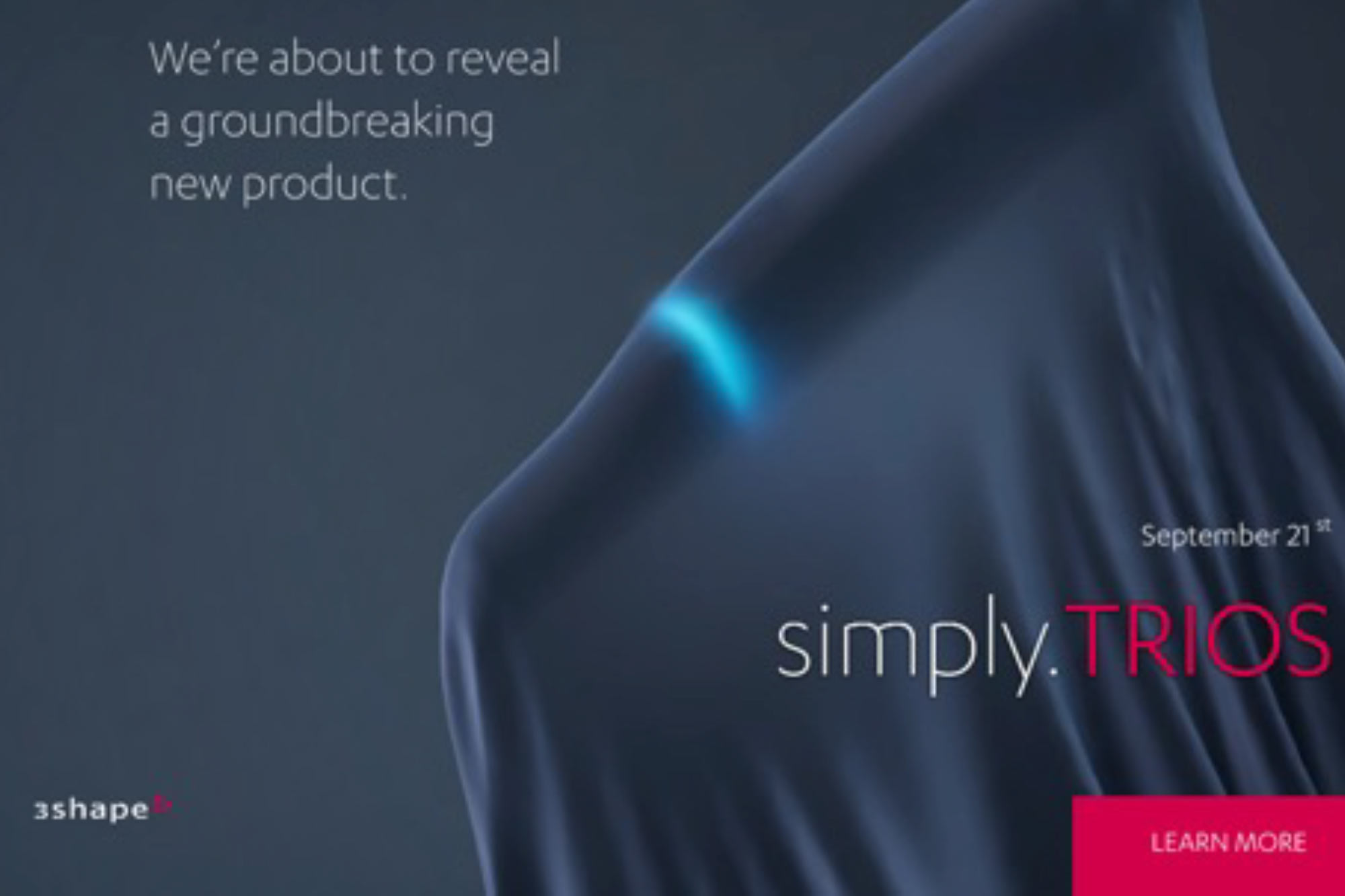
We hear from 3shape’s Erfan Abolfazli about why there might be a lot more to wireless intraoral scanning than we think.
On 21 September, 3shape will introduce a product that they believe will be the new gold standard in digital dentistry – and you can join the online even. They believe they have taken something advanced and made it simple, intelligent, and a true joy to use and share. And they can’t wait to share it with you!
Attend this event if you want to:
- Experience a more hygienic way of working;
- Give yourself, and your patients, a more comfortable and convenient experience
- Make your workflows an easier experience.
Learn more at https://utm.io/ueU8v
Back in 2017, 3Shape rocked the dental industry by releasing the world’s first and only wireless intraoral scanner. Four years later, two more intraoral scanner makers joined in by introducing their own wireless models to the market.
Wireless intraoral scanning has certainly made an impact. Professionals rave about the benefits of not having a wired connection to the PC – no cable draped across the patient, no more accidentally pulling the scanner off the table, and improved ergonomics when scanning.
But are the three wireless intraoral scanners in the market the same? We spoke with Erfan Abolfazli, a product manager in 3shape who specialises in wireless connectivity. It seems there might be a lot more to wireless scanning than we think.
Making a connection and sending data back and forth
When intraoral scanning wirelessly, your scanner needs to send a huge amount of data continuously and for arguments sake, almost instantly back to your PC.
To accomplish this data transfer, one of the competitor scanner-makers sends data on a 60 GHz frequency between its scanner and its own proprietary wifi hub.
Erfan Abolfazli, 3shape’s product manager and wireless connectivity specialist, says: ‘To move tons of data quickly you want to use a frequency like 60 GHz.
‘But the major problem with 60 GHz is that it needs a completely clear path for the connection. For example, between the wireless scanner and the wifi hub.
‘So, if your assistant walks in front of the scanner or even you, while you’re scanning, you can risk losing the connection.’
‘The challenge with 60 GHz is also why one of the competitor scanners that uses the 60 GHz frequency requires you to attach its own wifi hub and special holder to the top of your PC monitor.
‘They are trying to make sure that nothing gets in front and blocks the connection between the hub and the scanner. They need to ensure a clear line of sight from the scanner to the wifi hub. It’s also why they recommend not to move the scanner more than five meters from the hub and PC. And you need an extremely powerful PC to run their wireless solution.’
In contrast, 3shape and another competitor use a 5 GHz frequency for their connection. This is what the standard wifi frequency used in pretty much every home and dental practice wifi in the world runs on.
This lower frequency can send data through virtually anything. But it will not transmit as much large data so quickly.
How then does 3shape transfer so much data wirelessly?
3shape has solved the large data transfer problem by processing its scans first within the scanner. This is done before the scanner even sends the scan to the PC. In doing so, we significantly reduce the amount of data that needs to be sent between the scanner and the PC. And as a result, the data transfer is just as fast and doesn’t need a higher frequency like 60 GHz.
Erfan says: ‘Regardless of the scanner maker, an intraoral scanner and its software require a lot of computer power or the CPU or GPU resource to run smoothly and properly. So aside from the scanner, you need a super strong computer with the processing power to handle the imaging.
‘The 3shape Trios wireless scanners process the data first before they transmit it from the scanner to the PC. In that way, it enables our solution to run smoothly and, theoretically, can use any standard wifi for example, 5 GHz, to send data.
‘You can compare this with one of the competitor’s, which does not process any of the data within the scanner. Therefore, it needs 60 GHz to send the scans.
‘It’s also why their intraoral scanner needs a very powerful PC and to connect via their proprietary wifi hub.’
So, am I really wireless with a wireless intraoral scanner?
Abolfazli says: ‘That’s an interesting question. I think the ideal wireless setup would be, if first, and most importantly, you did not have to worry about the scanner getting disconnected because somebody walks in front of the PC.
‘But really, for me, the ideal set-up would be that you could walk from operatory to operatory with just one scanner in your hand.
‘And then I guess, use whatever PC was in the respective operatory. Maybe even do this over the practice’s existing wifi network. There would be no need for wifi hubs for each PC.
‘I know with that type of scenario the competitor’s scanner would require a powerful PC with a wifi hub in every single operatory. So, the scanner could then connect to each PC.
‘But that ends up defeating the idea, because you are really just connecting to each individual computer via that 60 GHz wifi hub. It’s like buying an individual system set-up for every room. That could be expensive.
‘I also just don’t see it being practical to run a 60 GHz frequency Wi-Fi throughout the practice. It would be too challenging and impractical. It would also be too tough to setup and require that the signal is never blocked anywhere.
‘However, with a lower frequency like the one TRIOS uses, then the Wi-Fi coverage is much more robust in the practice, so that eliminates the connectivity challenges. It could certainly be done.’
Consulting the crystal ball on a ‘truly wireless’ setup
He adds: ‘If I looked into a crystal ball, I could see in the future the idea of walking from operatory to operatory and using your Trios with any PC in the practice becoming a definite reality.
‘And importantly, doing so without having to buy any more software or scanner licenses…just go from laptop to laptop using the practice’s normal wifi or wired network.
‘You could then walk from room to room with Trios in your hand because it’s connected by wifi, and then you would just use whatever PC was in the respective operatory.
‘With that type of setup, you would be truly wireless.’
‘Trying to do that with 60GHz would get expensive fast’
In an article on the cons of setting up 60 GHz networks from in Poc Network – Tech magazine, the magazine stated: ‘With 60 GHz you can move a lot of data quickly across your network. However, you begin to lose connection past a short distance away. It isn’t ideal for covering a good-size home.’
In fact, the magazine warns that ‘you would be lucky to cover about 30% of a home, with the best success/reliability being a room away from it at most. Sure, there are ways to make it a little more powerful, but it just isn’t efficient…trying to do that with 60GHz would get expensive fast.’
Maximising your investment on a wireless intraoral scanner
If you aspire to be digital and wireless with your dental practice, you need to ideally have the ability to scan from every PC in your practice. That would maximise your investment in an intraoral scanner. In that way, one scanner would cover the entire practice.
In the old days, we could walk from room to room with analog impression material and mixing trays or stone models. Not the most hygienic solution and hopefully, none of your colleagues had fumble fingers but it worked.
For now, digital impression solutions haven’t yet solved the convenience of moving the impression-taking from room-to-room unless you own a Trios Move, but you still need to unplug it.
For the time being, if you want to use your scanner anywhere in your practice, you’ll need to take your PC or Move with you (at least for the near future).
If someone comes along and solves this challenge based on Erfan’s vision, then you’ll have a truly digital dental practice.
Join 3shape on 21 September https://utm.io/ueU8v



